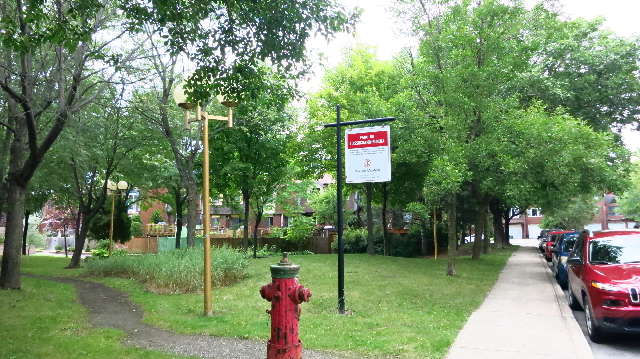Being on and off the urban circulation grid
The gridiron layout of North American urban circulation spaces, as opposed to the more organic village or town circulation and gathering spaces layout, has conditioned, for the sake of orientation and choice of itinerary, an on-or-off grid principle of spatial organization of the city.
On-grid circulation spaces provide an easy perceptual handle so the speak, in terms of their location in the general circulation network, particularly if numbers and names in a certain order are used for their identification as streets, avenues, places, crescents, etc.
We seldom refer to these as generic pathways in ordinary discussion, reserving the cousin term of path for less formal circulation spaces that are rather reserved for pedestrians and bicycles and that usually run within-and-parallel to on-grid circulation.
Unless laid out in closed circuit manner, off-grid paths found within urban block enclaves will usually join on-grid, block defining, circulation spaces such as neighbourhood streets or main arteries.
Paths running off-grid generally introduce a break in the usual street and building urban grid, a break in urban scale and in orientating image that will raise one’s spatial awareness and curiosity, at the cost of some modification to one’s mental image of the city.
A marginally off-grid paved path
In our very first post we had used this example of a break in the grid orientation of the neighbourhood, consisting of three cross-block parallel circulation “places” by name, but pedestrian paved “paths” by size and function. These run perpendicular to a neighborhood street at one end and a cross town artery, at the other (see image above).
The rows of duplex building entries face each other across the path instead of the heavily trafficked streets, and, since the place-paths have a name each building gets to have a civic number address on what is essentially a hedge lined paved walkway.
We had noted in that first post the fact that a front-back drop in level allowed these buildings to have rear basement level garage entrances serviced by a back alley, wide enough to confuse drivers as to its public accessibility from surrounding streets (see, in image below, clothes line across the back alley … hardly a “normal” sight in accessible public streets).
It all adds up to pleasant surprise or useless frustration … depending on one’s state of mind, or one’s schedule!
A resolutely off-grid dirt path
The above image shows the place where a dirt path, crossing a mid block common open space, abuts a block bordering street at a point equipped with park light and park identification hanging sign.
(We have used this image, in our post concerning the neighbourhood as commons, to illustrate how the social economic movement that gave birth to the neighbourhood housing development was recognized in the very name of the park.)
What we did not show was the other extremity of the path that is not identified in any way by name or other orienting feature (see image below)
What we have here is a path so located along the backyard fencing that it conveys mixed signals: is it an exit from the backyards and a mean of access to the block bordering street I am standing on, in which case it is a private path? Is it a shortcut going from the street I am standing on to the next bordering street, in which case it is more of public path?
Questions of no mean importance if the signals are misinterpreted.
(My informant described how it was her dog, following its sent of squirrel, that pulled her into what proved to be a common landscaped space of more use to the passerby than to the people living around it who cherish their privacy…if I can trust my informant observations.)
Discussion
Both of these urban paths by the virtue of their being marginally off-grid for the first, and resolutely off-grid for the second, offer opportunities for explorations of a social and spatial nature.
Since they are “shrouded” with uncertainty as to their public or private nature they ask one to proceed with care, conscious of having to justify one’s present in terms of the signs that could be interpreted that way.
Off-grid paths have been, for me, a continuous source of pleasant environmental design surprise, and continuous learning opportunities of their subtle territorial codification.
I have come to consider these on-or-off grid paths as creators of “urban rooms” of sorts, raising the question of their territorial status i.e. of the relative exclusivity of their use by the occupants of the fronting buildings.
To speak of circulation spaces as “rooms” is to recognize their impact upon our spatial imagination as a “Here”, and not only as a way to go from Here to There.
The fact that the name of “ place”, instead of street, was given to each of the three marginally off-grid paths stands as confirmation of this environmental subtlety.
All photos credit Maurice Amiel




